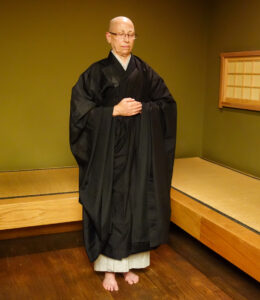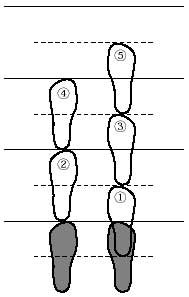Practice
The foundation of the Soto Zen School‘s teachings is zazen. This originated with Shakyamuni Buddha who devoted himself to the practice of zazen and subsequently attained enlightenment. “Zen” refers to seeing into and discerning the truth of the way things are, then harmonizing the mind to properly correspond with that understanding. It is also to maintain the harmony of body, breath, and mind by sitting in a stable position with a focused mind.
The zazen of Soto Zen School is “shikantaza,” which is to sit single-mindedly. Zazen isn’t a means to achieve some sort of goal. The form (posture) of zazen itself is the form (posture) of buddha; it is the form of enlightenment. In our everyday lives, we tend to be swayed by our selfish desires as well as by the surface of things. In zazen, however, the important thing is to be free from all sorts of delusions and desires.
Dogen Zenji also taught that the practice of zazen isn’t only sitting, but discovering that all of our everyday activities have the same value as zazen to do them as the practice of Zen. It may seem as if practice is something special, somehow removed from regular life. However, our practice is to undertake all our daily activities as if they were the same as zazen and to continue and maintain that practice.
Video: How to do Zazen
“How to do Zazen”
The Place
When you do zazen, find a quiet place where you can sit without disturbances. It should be neither too dark nor too bright, warm in the winter and cool in the summer. The sitting place should be neat and clean.
If possible, a statue of Manjushri Bodhisattva should be enshrined in the room. If there is none available, any statue or painting of a Buddha or a Bodhisattva is fine. Also, when possible, place an offering of flowers on the altar and burn incense.
Preparing yourself
Avoid sitting when you haven’t had sufficient sleep or when you are physically exhausted. Before sitting, eat moderately and avoid alcohol. Wash your face and feet so that you feel refreshed.
Clothing
Avoid wearing soiled clothing or garments which are luxurious or expensive. It is also advisable to avoid heavy garments. Wear your clothing loosely but neatly. In Japanese Zen monasteries, socks are not worn in the zendo.
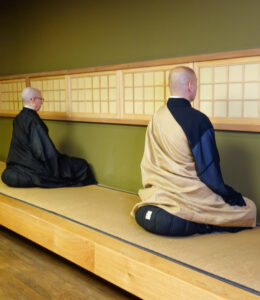
Position of the zafu
Place a thick square mat (zabuton) in front of the wall and put a zafu on it. Sit down, placing the base of your spine at the center of the zafu so that half of the zafu is behind you. After crossing your legs, rest your knees firmly on the zabuton.
Crossing your legs(1): full-lotus position (kekkahuza)
Place your right foot on your left thigh, and then your left foot on your right thigh. Cross your legs so that the tips of your toes and the outer edge of your thighs form a single line.
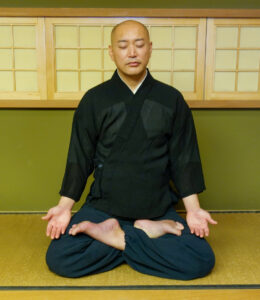
Crossing your legs(2): half-lotus position (hankahuza)
Simply place your left foot on your right thigh. When you cross your legs, your knees and the base of your spine should form an equilateral triangle. These three points support the weight of your body. In full-lotus position (kekkahuza), the order of crossing the legs may be reversed, and in half-lotus position (hankahuza), raising the opposite leg is acceptable.
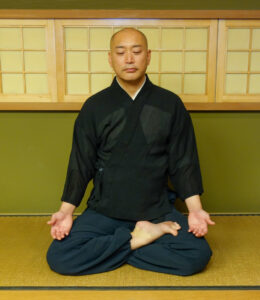
Posture
Rest both knees firmly on the zabuton, straighten the lower part of your back, push your buttocks outward and hips forward, and straighten your spine. Pull in your chin and extend your neck as though reaching toward the ceiling. Your ears should be in a line parallel to your shoulders, and your nose should be in line with your navel. After straightening your back, relax your shoulders, back, and abdomen without changing your posture. Sit upright, leaning neither to the left nor right, neither forward nor backward.
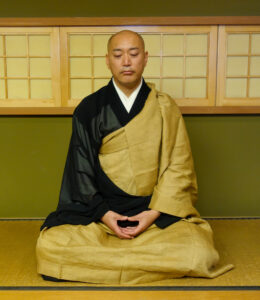
Cosmic Mudra (Hokkaijoin)
Place your right hand, palm-up, on your left foot, and your left hand palm-up on your right palm.The tips of your thumbs should be lightly touching each other. This is called Cosmic Mudra (hokkai-join). Place the tips of your thumbs in front of your navel, and your arms slightly apart from your body.
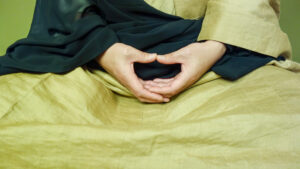
The mouth
Keep your mouth closed, placing your tongue against the roof of your mouth just behind your teeth.

The eyes
Keep your eyes slightly open. Cast them downward at about a 45-degree angle. Without focusing on any particular thing, let everything have its place in your field of vision. If your eyes are closed, you will easily drift into drowsiness or daydreaming.
Exhale completely and take a breath (Kanki-issoku)
Quietly make a deep exhalation and inhalation. Slightly open your mouth and exhale smoothly and slowly. In order to expel all the air from your lungs, exhale from the abdomen. Then close your mouth and continue to breathe through your nose naturally. This is called kanki-issoku.
Swaying the body
Place your hands palms-up on your knees and sway the upper half of your body from left to right a few times. Without moving your hips, move the trunk as if it were a pole leaning to one side then the other, so that the waist and hip muscles are stretched. You may also sway forward and backward. At first this movement should be large, gradually becoming smaller and smaller, and ceasing with your body centered in an upright position. Once again forming the hokkai-join with your hands, assume an unmoving upright posture.
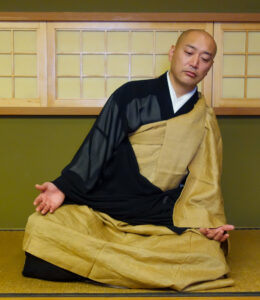
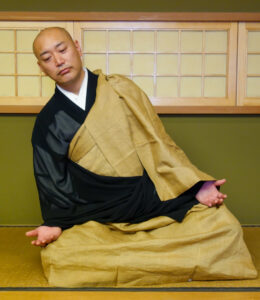
Abdominal breathing
During zazen, breathe quietly through your nose. Do not try to control your breathing. Let it come and go so naturally that you forget you are breathing. Let long breaths be long, and short breaths be short. Do not make noise by breathing heavily.
Awareness (Kakusoku)
Do not concentrate on any particular object or control your thought. When you maintain a proper posture and your breathing settles down, your mind will naturally become tranquil.
When various thoughts arise in your mind, do not become caught up by them or struggle with them; neither pursue nor try to escape from them. Just leave thoughts alone, allowing them to come up and go away freely. The essential thing in doing zazen is to awaken (kakusoku) from distraction and dullness, and return to the right posture moment by moment.
Getting up from zazen
When you finish zazen, bow in gassho, place your hands palms-up on your thighs, sway your body a few times, first a little, and then more extensively. Take a deep breath. Unfold your legs. Move slowly, especially when your legs are asleep. Do not stand up abruptly.
Kinhin
When doing kinhin, walk clockwise around the room, holding your hand in shashu position. From the waist up, your posture should be the same as that in zazen. Take the first step with your right foot. Advance by taking only half step for each full breath (one exhalation and inhalation).
Walk slowly and smoothly as if you were standing in one place. Do not drag your feet or make noise. Walk straight ahead, and when turning, always turn to right. The word kinhin means to go straight. When you finish kinhin, stop and bow. Then walk at a normal pace around the room until you return to your seat.
